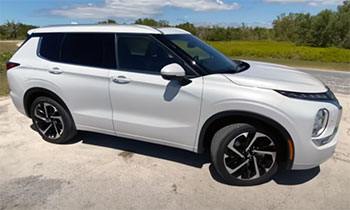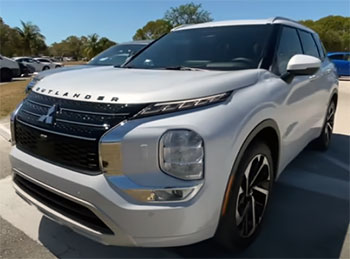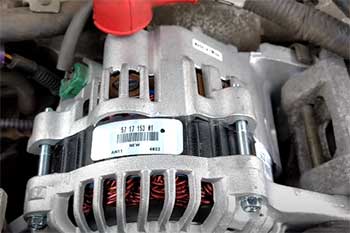I’m on a mission to find the perfect compact SUV, and I’ve narrowed it down to two heavyweights: the Mitsubishi Outlander and the Mazda CX-5. Both vehicles promise practicality, style, and performance, but which one truly delivers for my lifestyle?
Exploration, I’ll share my firsthand experiences, break down their pros and cons, and compare key features like performance, safety, and comfort. From driving dynamics to family-friendly features, I’ll help you decide which SUV suits your needs. Let’s hit the road and see how these two stack up!
Comparison Table: Mitsubishi Outlander Vs Mazda CX-5
| Feature | Mitsubishi Outlander | Mazda CX-5 |
|---|---|---|
| Base Price | ~$28,000 | ~$30,000 |
| Engine Options | 2.5L 4-cylinder (181 hp), PHEV (248 hp) | 2.5L 4-cylinder (187 hp), 2.5L turbo (256 hp) |
| Transmission | CVT | 6-speed automatic |
| _Fuel Economy (City/Highway) | 24/31 mpg (gas), 26/33 mpg (PHEV) | 26/31 mpg (base), 23/29 mpg (turbo) |
| Seating Capacity | Up to 7 | 5 |
| _Cargo Space (Behind 2nd Row) | 33.5 cu.ft. | 30 cu.ft. |
| Max Cargo Space | 78.3 cu.ft. | 59 cu.ft. |
| Towing Capacity | 2,000 lbs (gas), less for PHEV | 2,000 lbs |
| _Warranty (Basic/Powertrain) | 5-yr/60,000-mi, 10-yr/100,000-mi | 3-yr/36,000-mi, 5-yr/60,000-mi |
| Safety Rating | 5-star ANCAP (2022) | IIHS Top Safety Pick+ (2023) |
| Infotainment Screen | 9-inch touchscreen | 10.25-inch touchscreen |
| Standard Safety Features | AEB, lane-keep assist, blind-spot monitoring | AEB, adaptive cruise control, lane-keep assist |
My Experience With Mitsubishi Outlander

Stepping into the Mitsubishi Outlander, I immediately noticed its bold, muscular design.
The “Dynamic Shield” grille and sharp LED headlights give it a commanding presence, almost like it’s ready to tackle any adventure.
During my test drive, the cabin felt spacious, especially with the optional third-row seating, which is a rarity in the compact SUV segment.
I could see this being a game-changer for families needing extra seats, though I found the third row best suited for kids due to its snug fit.
The leather seats in the Exceed Tourer trim were plush, and the two-tone interior added a touch of flair, though I wasn’t sold on the orange “saddle tan” option—it’s bold, but not for everyone.
The 2.5-liter four-cylinder engine, delivering 181 horsepower, felt adequate for city driving but lacked the punch I craved on highways. The plug-in hybrid (PHEV) variant, with 248 horsepower, was a different story—its electric boost made merging a breeze, and I loved the idea of short electric-only commutes.
However, the continuously variable transmission (CVT) felt sluggish at times, especially compared to more responsive setups. Fuel economy was solid, hitting 24/31 mpg for the gas model and up to 33 mpg combined for the PHEV, which is a win for budget-conscious drivers.
The Outlander’s tech impressed me with its 9-inch touchscreen and Google API integration for navigation, though I noticed occasional lag. The MI-PILOT Assist system, with lane-centering and adaptive cruise control, made long drives less stressful, but I wished for smoother transitions in heavy traffic.
Safety-wise, the 2022 five-star ANCAP rating gave me confidence, backed by features like autonomous emergency braking and blind-spot monitoring. Cargo space was generous, with 33.5 cubic feet behind the second row, perfect for weekend getaways.
Overall, the Outlander felt like a practical, family-oriented choice with a strong warranty—5 years/60,000 miles basic and 10 years/100,000 miles for the powertrain. But its less engaging drive and slightly dated tech held it back from being my top pick.
Pros Of Mitsubishi Outlander

- Three-Row Seating Option: The Outlander’s ability to seat up to seven is a standout feature in the compact SUV class, making it ideal for larger families or those needing extra seats for carpools.
- Generous Warranty: Mitsubishi’s 5-year/60,000-mile basic and 10-year/100,000-mile powertrain warranty offers peace of mind, outpacing many rivals, including Mazda.
- Spacious Cargo Area: With 33.5 cubic feet behind the second row and up to 78.3 cubic feet with seats folded, the Outlander handles groceries, sports gear, or luggage with ease.
- Plug-In Hybrid Option: The PHEV model delivers 248 horsepower and up to 33 mpg combined, blending efficiency with performance for eco-conscious drivers.
- Bold Exterior Design: The “Dynamic Shield” grille and sleek LED headlights give the Outlander a modern, aggressive look that turns heads.
- Comprehensive Safety Suite: Standard features like autonomous emergency braking, lane-keep assist, and blind-spot monitoring, plus a 2022 five-star ANCAP rating, ensure safety.
- Affordable Servicing Costs: Over five years, servicing is nearly $1,000 cheaper than competitors like the Mazda CX-5, a boon for long-term ownership.
The Outlander’s practicality shines through its seating and cargo versatility, making it a top choice for families. The PHEV option is a forward-thinking touch, offering efficiency without sacrificing power. Its warranty and low maintenance costs are hard to beat, especially for budget-minded buyers. However, the third row’s limited space and occasional tech lag might not suit everyone.
Read More: My Thoughts On Acura MDX Vs. Lexus GX
Cons Of Mitsubishi Outlander
- Sluggish CVT Transmission: The continuously variable transmission feels unresponsive, especially during quick acceleration, making highway merges less confident.
- Cramped Third Row: While the seven-seat option is a plus, the third row is tight, best suited for children rather than adults or teens.
- Laggy Infotainment System: The 9-inch touchscreen, despite Google API integration, can be slow to respond, which is frustrating during navigation or media use.
- Less Engaging Drive: Compared to sportier rivals, the Outlander’s handling feels less dynamic, prioritizing comfort over excitement.
- PHEV Towing Limitation: The plug-in hybrid model has a reduced towing capacity compared to the standard 2,000 pounds, limiting its utility for heavy loads.
- Interior Material Quality: While functional, some plastics in lower trims feel cheap compared to premium competitors like the Mazda CX-5.
- Limited Dealer Network: With fewer Mitsubishi dealerships than Mazda, finding service or support can be less convenient, especially in rural areas.
The Outlander’s CVT and lackluster handling detract from the driving experience, and the third row’s limited space may disappoint those expecting full-size utility. Tech glitches and a smaller dealer network are notable drawbacks, particularly for buyers prioritizing convenience and performance.
My Experience With Mazda CX-5

Sliding into the Mazda CX-5 felt like stepping into a premium sedan rather than an SUV.
Its sleek, curvy design and polished interior screamed sophistication, with soft-touch materials and leather-trimmed seats in the Turbo Premium trim creating a near-luxury vibe.
The 10.25-inch touchscreen was crisp and intuitive, with wireless Apple CarPlay making my phone integration seamless.
Driving the base 2.5-liter four-cylinder (187 horsepower) was smooth for daily commutes, but the turbocharged version, pumping out 256 horsepower, turned heads with its zippy acceleration—perfect for spirited drives.
The CX-5’s handling was a highlight, with precise steering and a refined suspension that made winding roads a joy. Its six-speed automatic transmission felt snappy, a clear win over CVTs in competitors. Fuel economy was decent at 26/31 mpg for the base engine, though the turbo dropped to 23/29 mpg. Cargo space, at 30 cubic feet behind the second row, was slightly less than the Outlander but still practical for my needs. The 2,000-pound towing capacity matched the Outlander’s gas model, handling small trailers well.
Safety features were robust, with the CX-5 earning a 2023 IIHS Top Safety Pick+ rating. Adaptive cruise control and lane-keep assist worked flawlessly, though I noticed the system could be overly sensitive in tight urban settings. The warranty—3 years/36,000 miles basic and 5 years/60,000 miles powertrain—was less impressive than Mitsubishi’s. Still, the CX-5’s upscale cabin and engaging drive made it feel like a treat every time I got behind the wheel.
Pros Of Mazda CX-5
- Engaging Driving Dynamics: The CX-5’s precise steering and responsive suspension make it one of the most fun-to-drive compact SUVs, especially with the turbo engine.
- Upscale Interior: High-quality materials, leather upholstery, and a driver-focused cockpit give the CX-5 a near-luxury feel, outshining many rivals.
- Powerful Turbo Option: The 256-horsepower turbo engine delivers thrilling acceleration, perfect for drivers craving performance.
- Advanced Safety Features: With a 2023 IIHS Top Safety Pick+ rating, standard adaptive cruise control, and blind-spot monitoring, the CX-5 prioritizes safety.
- Responsive Transmission: The six-speed automatic shifts smoothly, offering a more engaging drive than CVT-equipped competitors.
- Premium Infotainment: The 10.25-inch touchscreen with wireless Apple CarPlay and Android Auto is intuitive and modern, enhancing connectivity.
- Strong Dealer Network: With over 64% more Mazda dealers than Mitsubishi, service and support are more accessible nationwide.
The CX-5’s sporty handling and luxurious interior make it a standout for drivers who value excitement and refinement. Its safety credentials and tech are top-notch, and the turbo engine adds a performance edge. Accessibility to dealers is a practical bonus for long-term ownership.
Cons Of Mazda CX-5
- Limited Seating Capacity: With only five seats, the CX-5 lacks the Outlander’s optional third row, making it less ideal for larger families.
- Smaller Cargo Space: Offering 30 cubic feet behind the second row and 59 cubic feet max, it trails the Outlander in storage versatility.
- Shorter Warranty: The 3-year/36,000-mile basic and 5-year/60,000-mile powertrain warranty is less generous than Mitsubishi’s offering.
- Higher Starting Price: At ~$30,000, the CX-5 is pricier than the Outlander’s ~$28,000 base, which may deter budget buyers.
- Tight Rear Legroom: Second-row legroom (39.6 inches) feels cramped for taller passengers compared to some competitors.
- Turbo Fuel Economy: The turbo engine’s 23/29 mpg is less efficient than the base model or the Outlander’s PHEV.
- Overly Sensitive Safety Systems: Features like lane-keep assist can be intrusive in urban settings, requiring frequent adjustments.
The CX-5’s lack of a third row and smaller cargo area limit its family appeal, and the shorter warranty and higher price may give budget-conscious buyers pause. Rear legroom and sensitive safety tech could also frustrate some users.
Comparison With Other Brands
- Nissan X-Trail: Sharing a platform with the Outlander, the X-Trail offers similar seven-seat versatility but has a less refined interior. Its pricing ($38,025-$59,265) is higher, and its CVT feels equally sluggish, making the Outlander a better value.
- Honda CR-V: Priced from $41,900, the CR-V offers a roomy cabin and hybrid option but lacks a third row. Its smoother CVT and better fuel economy (28/34 mpg) outshine the Outlander, though the CX-5’s handling is more engaging.
- Toyota RAV4: A top seller starting at ~$30,000, the RAV4 matches the CX-5’s five-seat layout and offers a hybrid model (41/38 mpg). Its interior feels less premium than the CX-5, but its reliability reputation is stronger than both contenders.
- Hyundai Tucson: Starting at ~$29,000, the Tucson boasts modern tech and a bold design. Its 38.7 cubic feet of cargo space beats the CX-5, but its less dynamic handling makes it less appealing than Mazda’s offering.
- Kia Sorento: Priced higher ($50,880-$84,660), the Sorento offers three rows like the Outlander but with a more upscale interior. Its turbo engine rivals the CX-5’s, though its cost makes the Outlander a budget-friendly alternative.
The Outlander’s seven-seat option gives it an edge over the RAV4 and Tucson for families, while the CX-5’s driving dynamics and interior quality surpass the X-Trail and CR-V. Both face stiff competition from the RAV4’s reliability and the Sorento’s premium features.
Read More: My Thoughts On Ford Escape Vs. Mazda CX-5
Frequently Asked Questions (FAQ)
Mazda generally edges out Mitsubishi in reliability, with higher ratings from sources like Consumer Reports. The CX-5’s proven powertrain and fewer reported issues make it a safer bet, though Mitsubishi’s longer warranty offers peace of mind.
The Outlander’s CVT is sluggish, the third row is cramped, and the infotainment can lag. Its handling lacks excitement, and the limited dealer network may complicate service.
The Nissan X-Trail, Honda CR-V, and Kia Sorento are comparable, offering similar size and features. The X-Trail shares its platform, while the CR-V and Sorento provide hybrid options and competitive pricing.
The CX-5 lacks a third row, has less cargo space than the Outlander, and offers a shorter warranty. Its rear legroom is tight, and the turbo engine’s fuel economy is less impressive.
Conclusion
Choosing between the Mitsubishi Outlander and Mazda CX-5 depends on what you value most. If you need space, a third row, and a stellar warranty, the Outlander’s practicality and affordability make it a strong contender. Its PHEV option is a bonus for eco-conscious drivers. However, if you crave a fun, premium driving experience with a luxurious interior, the CX-5 steals the show with its sporty handling and upscale cabin. Both SUVs have their strengths, but for me, the CX-5’s engaging drive and refined feel tip the scales. Which one fits your lifestyle? Test drive them and find out!

